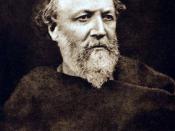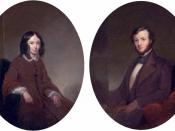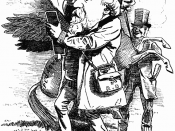Interpretations of "Porphyria's Lover"
Robert Browning's "Porphyria's Lover" is one of his most variously interpreted poems. The Interpretations include murder, vampirism, religion, madness, psychological complexity, sociological case study, fantasy, and erotic asphyxiation. Three that could be considered the most interesting include the suggestion of vampirism, religion, and erotic asphyxiation.
First, the idea of vampirism is one way a reader can interpret "Porphyria's Lover". Burduck states, "The virtually ignored Gothic features [â¦] create a dramatic soliloquy in which the speaker attempts to justify his murder of Porphyria by suggesting that she was a vampire" (par. 1). While the variations in the meaning of Porphyria's name collectively conjure images of the "undead", the speaker also selects specific details that suggest a vampiric view of Porphyria. For instance, Porphyria can be defined as a type of serpent, a variety of marble extremely sensitive to light, and if used as an adjective pertains to antagonist of Christianity.
Taken into consideration together, the snake or "serpent" may suggest evil and the dagger-like fangs of the legendary vampires which despise Christian symbols and react adversely to light. Furthermore, the narrator speaks of Porphyria's demonstration of abilities, her serpent-like movement, and her sexual advances as a part of the vampire's arsenal. He speaks of his own weakness and paleness, and inability to resist her as another example of vampirism within the poem. In the last line "and yet God has not said a word" (Browning, line 60), the speaker justifies the murder of Porphyria because he has saved his own soul by killing one of hell's voracious minions.
Secondly, religion is another interesting interpretation of "Porphyria's Lover". While completely opposite of "vampirism", the idea of a religious interpretation can be observed within various lines of "Porphyria's Lover". For instance, Porphyria comes in from the cold, stormy weather and immediately kneels and lights a fire. This can be compared to a Catholic parishioner entering the church, lighting a candle, and kneeling to pray before mass begins. It can also be questioned if Porphyria's lover sees himself in a Godly way or Porphyria as Mary, mother of God. As Wilken suggests, several examples indicate how one could conclude the narrator's portrayal of this. For instance, in the third paragraph Wilken's discusses lines 36-39 of the poem, and then says "He decides to accept her flawless sacrifice and kill her, just as anyone would do in a similar erotic situation. Like, God he puts his lamb to death" (Wilkens, par. 6). Thus, giving an example of how Porphyria's Lover has compared himself to God. Furthermore, it is also suggested that Porphyria is compared to Mary, mother of God. Examples of this are expressed by Wilken's suggestion of how Porphyria's removal of her cloak and shawl are "an image of Mary with halo" (par.3). In addition, when "[the lover] opens her eyes, unties the cord, kisses her, and sets her up" (par. 7), it can be compared to him "taking care an idol or statue of Mary" (par. 7). Altogether, it can be concluded of how "religion" or a religious view may be seen by the reader.
The final interpretation, erotic asphyxiation, is the one with the most supported evidence of the three. Erotic asphyxiation is the "use of some type of mechanism to impede the flow of oxygen to the brain in order to heighten sexual pleasure" (Ross par.4). As the speaker, Porphyria's lover, says "She put my arm about her waist / And made her smooth white shoulder bare" (Browning, lines 16-17), it is apparent she is making her sexual desires known. Wanting to please her, "I debated what to do" (Browning, line 35); he is unsure if this is the best way. Realizing how much she "loved" him, he decides to fulfill her desires. Wrapping her long yellow hair, he strangles her. However, when Browning's narrator dictates, "No pain felt she; / I am quite sure she felt no pain. [â¦] I warily oped her lids: again/ Laughed the blue eyes without a stain. / And I untightened next the tress/ About her neck; her cheek once more / Blushed bright beneath my burning kiss:" (Browning qtd. in Ross, par 3.), you can clearly see he did not murder her. Because she regains the color in her cheeks, and her eyes were not bloodshot from the popping of blood vessels as in a murderous strangulation, this is apparent. Furthermore, stating "The smiling rosy little head [â¦] her darling one wish would be heard [â¦] And yet God has not said a word! (Browning, lines 51-60), he has now satisfied Porphyria's desire, and because he did not in fact kill her God has not frowned upon his actions.
While all three of these interpretations are clearly unrelated, they are all great suggestions of what Robert Browning was attempting to portray in "Porphyria's Lover". Browning's use of words entails his complexity of the true meaning of "Porphyria's Lover", which is left completely up to the reader. Thus, the suggestion of vampirism, religion, and erotic asphyxiation, can clearly be seen throughout various lines and aspects within this poem. In conclusion, "Porphyria's Lover", can be noted as one of Browning's most variously interpreted (therefore best) poems ever written.
Works Cited
Burduck, Michael L. "Browning's Use of Vampirism in 'Porphyria's Lover,'." Studies in Browning and His Circle 14 (1986): 63-65. Rpt. in Poetry for Students. Ed. Anne Marie Hacht. Vol. 15. Detroit: Gale Group, 2002. Literature Resource Center. Web. 28 Feb. 2012.
Ross, Catherine. "Browning's Porphyria's Lover." The Explicator 60.2 (2002): 68+. Literature Resource Center. Web. 28 Feb. 2012.
Wilkens, G. Psychopathic "Prayer: the religious dimension in 'Porphyria's Lover.'" The religious dimension in Browning's "Porphyria's Love." Poets.org: Academy of American Poets, 01 Jun 2005. Web. 28 Feb. 2012.


